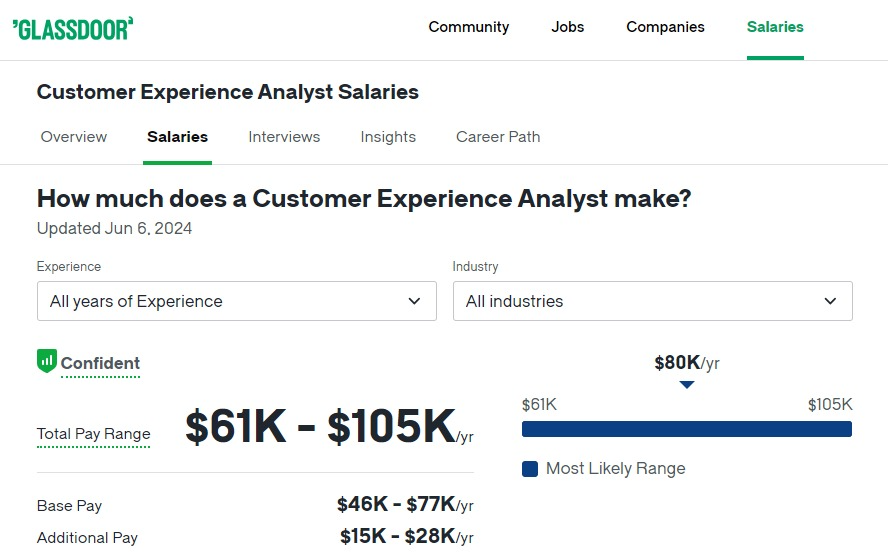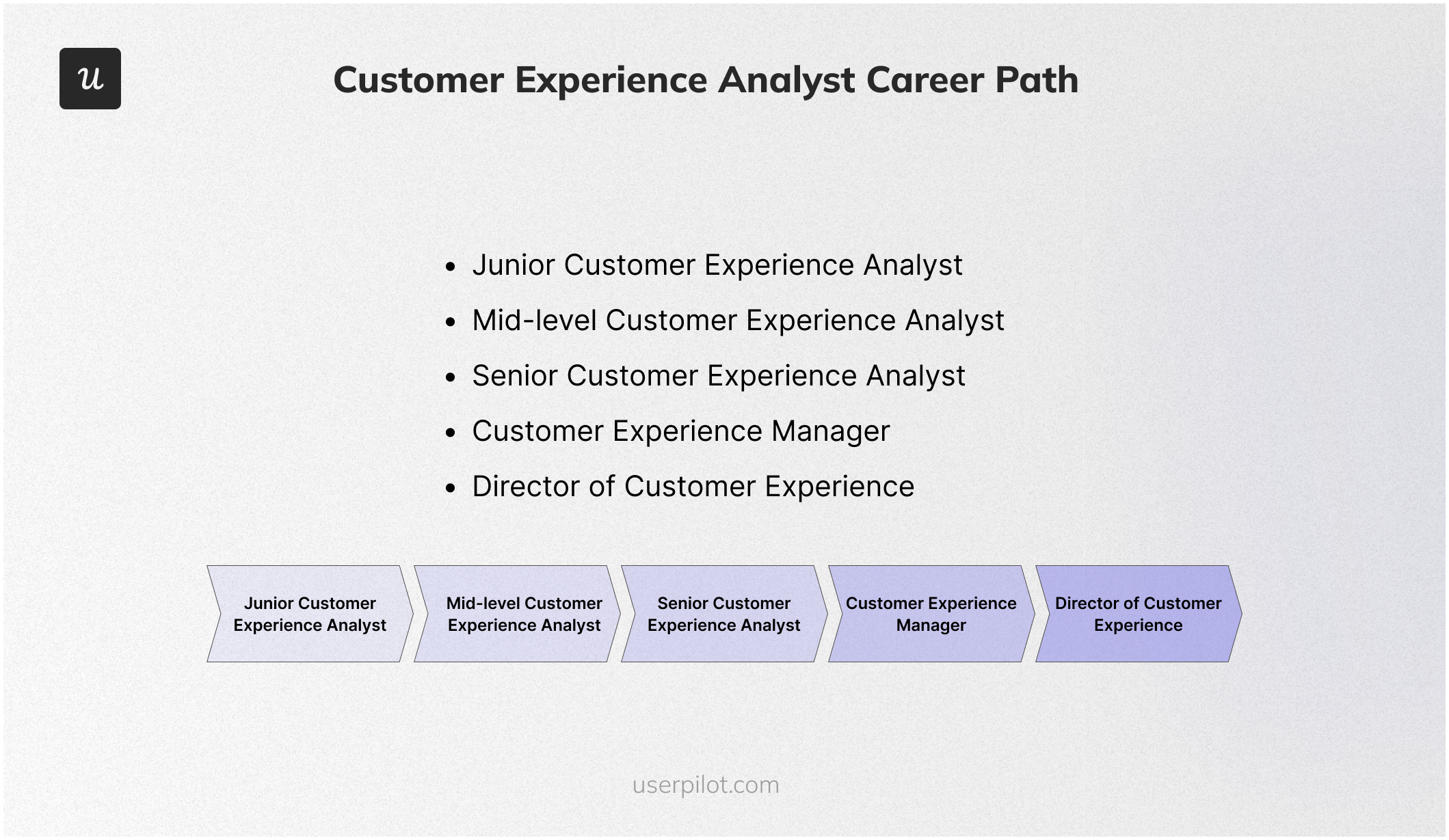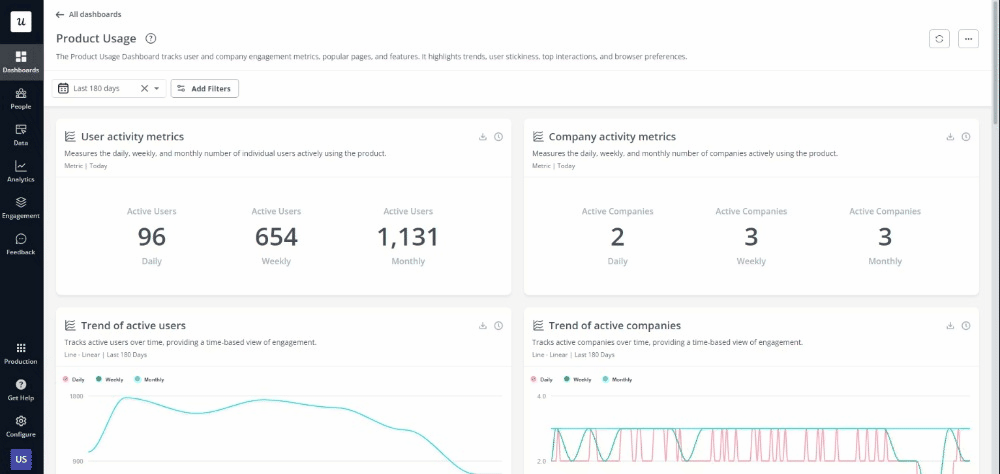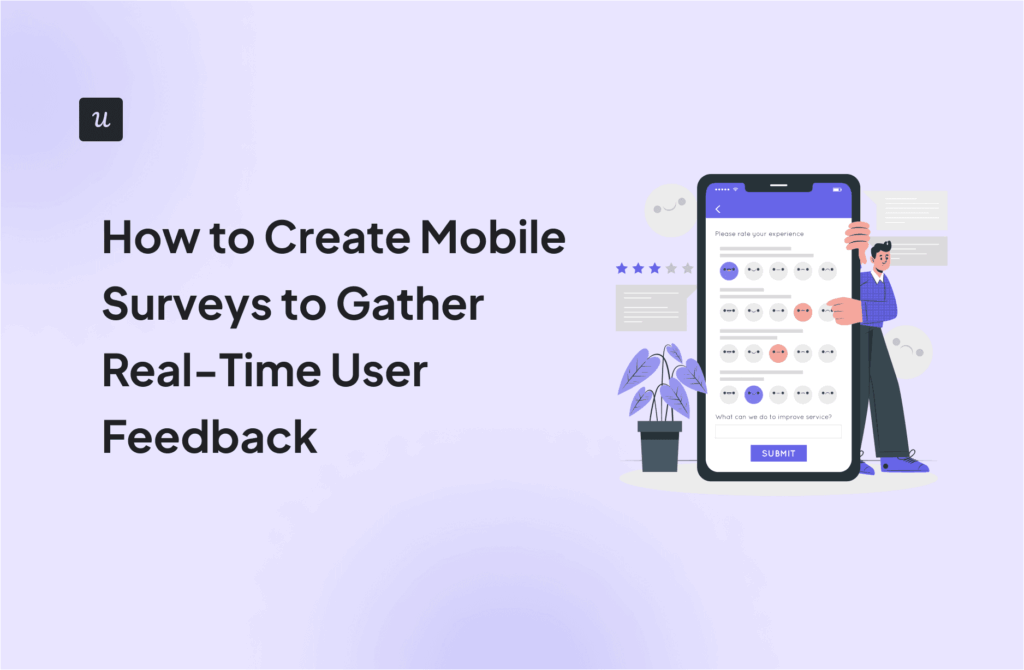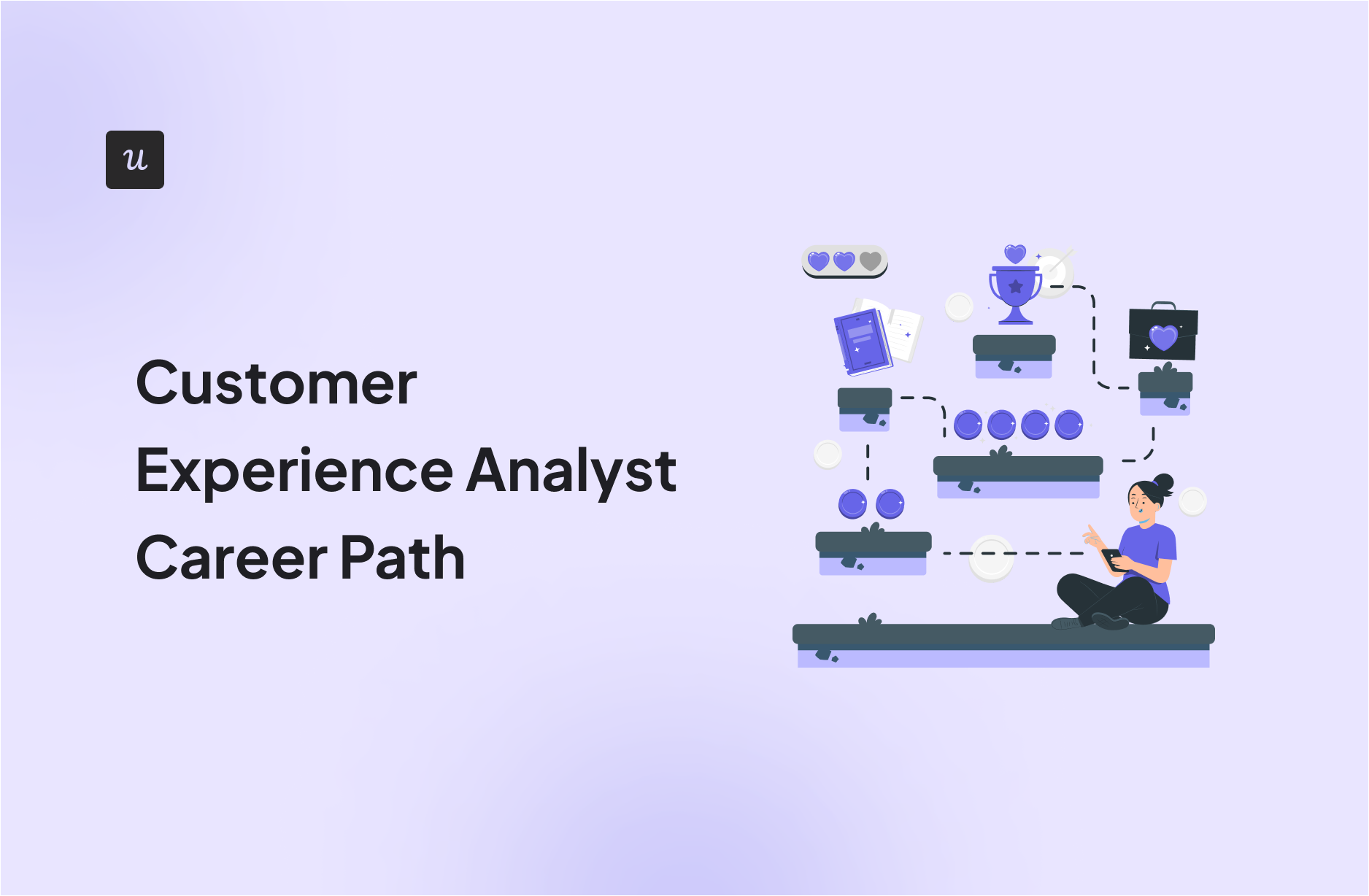
Starting a career as a customer experience analyst requires understanding the key steps, skills, and experiences needed for success.
In this article, we will outline the typical journey for customer experience analysts, covering educational requirements, entry-level positions, potential advancements, and long-term opportunities.
Without further ado, let’s get into it!
Try Userpilot Now
See Why 1,000+ Teams Choose Userpilot

What is a customer experience analyst?
A customer experience analyst is a professional who evaluates and improves the interactions between a company and its customers.
In the SaaS industry, they analyze customer data, feedback, and behaviors to enhance user satisfaction and retention, ensuring the software meets user needs and expectations.
What does a customer experience analyst do?
A customer experience analyst assesses customer interactions and experiences with a company’s products or services.
They collect and analyze data from various touchpoints, identify pain points, and provide actionable insights to improve customer satisfaction and loyalty.
In SaaS, they focus on optimizing user experience, onboarding processes, and feature usage.
Customer experience analyst’s main responsibilities
Customer experience analysts play a vital role in ensuring a company’s customers are satisfied and engaged.
Here are the main responsibilities and duties of a customer experience analyst, particularly in the SaaS industry:
- Collect and analyze customer feedback: Gather data from surveys, reviews, and support tickets to identify common issues and areas for improvement.
- Develop customer journey maps: Create visual representations of customer interactions with the product to highlight pain points and opportunities.
- Monitor customer experience metrics: Track key performance indicators such as NPS, CSAT, and churn rate to measure customer satisfaction.
- Collaborate with cross-functional teams: Work with product, marketing, and support teams to implement solutions based on customer insights.
- Conduct usability testing: Test new features and updates to ensure they meet customer needs and expectations.
- Provide actionable insights: Present findings and recommendations to stakeholders to drive product and service improvements.
Customer experience analyst salary
Understanding the salary range for customer experience analysts can help you gauge the earning potential in this field. Here’s a comparison of salaries based on experience level and location, sourced from Glassdoor, Indeed, and Reed.
Experience Level:
- Junior Customer Experience Analyst (2-4 years): $55,000 – $70,000 per year
- Mid-level Customer Experience Analyst (5-7 years): $75,000 – $90,000 per year
- Senior Customer Experience Analyst (8+ years): $95,000 – $120,000 per year
Location-Based Salaries:
- San Francisco: $90,000 – $120,000 per year
- New York: $85,000 – $110,000 per year
- Boston: $80,000 – $105,000 per year
- Washington, DC: $78,000 – $100,000 per year
- Chicago: $75,000 – $95,000 per year
Customer experience analyst career path
A career as a customer experience analyst offers various growth opportunities.
Here’s a typical career path detailing how you can progress in this field:
- Junior Customer Experience Analyst: Start with entry-level positions focusing on data collection and basic analysis.
- Mid-level Customer Experience Analyst: Take on more responsibilities, including developing customer journey maps and providing strategic recommendations.
- Senior Customer Experience Analyst: Lead a team, manage larger projects, and drive high-level strategy for customer experience improvements.
- Customer Experience Manager: Oversee the entire customer experience function, including strategy, implementation, and performance measurement.
- Director of Customer Experience: Lead the customer experience department, set company-wide CX goals, and report to executive leadership.
How to become a customer experience analyst
If you’re interested in pursuing a career as a customer experience analyst, here’s how you can get started. Focus on education, gaining relevant experience, and building essential skills.
To become a customer experience analyst, start with a bachelor’s degree in Business, Marketing, Data Science, or a related field. Gain experience through internships or entry-level positions in customer service, data analysis, or marketing. Develop skills in data analysis, customer journey mapping, and usability testing. Certifications in customer experience or data analysis can also enhance your qualifications.
Best resources for customer experience analysts
Staying updated with the latest trends, tools, and best practices is essential for a customer experience analyst. Here is a curated list of top resources, including books, webinars, podcasts, blogs, and certifications, to help you excel in this role.
Best books for customer experience analysts
Reading books by industry experts can provide valuable insights and strategies. Here are some of the best books for customer experience analysts:
- “The Effortless Experience” by Matthew Dixon: A guide to reducing customer effort and improving loyalty.
- “Outside In” by Harley Manning: Insights on transforming customer experience from a leading research firm.
- “Measuring Customer Satisfaction and Loyalty” by Bob E. Hayes: Practical methods for gauging customer satisfaction and loyalty.
- “Customer Experience 3.0” by John A. Goodman: Strategies for delivering exceptional customer experiences in the digital age.
- “The Customer Experience Book” by Alan Pennington: A comprehensive guide to creating memorable customer experiences.
Best webinars for customer experience analysts
Webinars are an excellent way to stay informed about the latest trends and best practices in customer experience. Here are some of the top webinars to consider:
- Userpilot Webinars: In-depth sessions on user onboarding and customer success. Visit the Userpilot website for more details.
- Zendesk Webinars: Discussions on improving customer support and service.
- HubSpot Academy: Webinars on customer experience and service best practices.
- Tableau Live: Sessions on data visualization and analysis techniques.
- Churnzero Webinars: Insights on reducing churn and improving customer success.
Best blogs for customer experience analysts
Blogs provide ongoing insights, tips, and updates from industry experts. Here are some of the best blogs for customer experience analysts:
- Userpilot Blog: Articles on user onboarding, customer success, and SaaS growth. Visit Userpilot blog for more details.
- Zendesk Blog: Tips and trends in customer support and experience. Visit Zendesk blog for more details.
- HubSpot Service Blog: Insights on improving customer service and experience. Visit HubSpot Service blog for more details.
- Tableau Blog: Data visualization techniques and best practices. Visit Tableau blog for more details.
- Churnzero Blog: Strategies for customer success and reducing churn. Visit Churnzero blog for more details.
Best podcasts for customer experience analysts
Listening to podcasts is a convenient way to learn from industry leaders and stay updated on the latest trends. Here are some recommended podcasts for customer experience analysts:
- “The Customer Support Leaders” podcast: Interviews with customer support leaders sharing their experiences. Available on major podcast platforms.
- “Call Center Helper” podcast: Tips and strategies for enhancing customer service and support. Available on major podcast platforms.
- “Customer Success Conversations” podcast: Discussions on customer success strategies and trends. Available on major podcast platforms.
- “The CX Leader Podcast” by Walker: Insights on customer experience leadership and best practices. Available on major podcast platforms.
- “The Intuitive Customer” podcast: Exploring the psychology behind customer decisions and experiences. Available on major podcast platforms.
Best tools for customer experience analysts
Utilizing the right tools can streamline your work and enhance your productivity as a customer experience analyst.
Here are some of the best tools categorized by their use case:
- Userpilot – Best tool for user onboarding: Helps create personalized onboarding experiences without coding.
- Zendesk – Best tool for customer support: Comprehensive solution for managing customer support tickets and interactions.
- Google Analytics – Best tool for website analytics: Provides insights into website traffic and user behavior.
- HubSpot Service Hub – Best tool for customer service management: Manages customer interactions and provides valuable service insights.
- Tableau – Best tool for data visualization: Transforms data into interactive and shareable dashboards.
- Custify – Best tool for customer success management: Helps reduce churn and increase customer lifetime value.
- Freshdesk – Best tool for multi-channel support: Manages customer inquiries from multiple channels in one place.
- Churnzero – Best tool for churn prediction: Identifies at-risk customers and helps reduce churn.
- Zoho Desk – Best tool for ticket management: Streamlines customer support operations with efficient ticket management.
- Jira Software – Best tool for project management: Tracks and manages projects, ensuring timely delivery and collaboration.
Conclusion
We hope our article has given you a good overview of the career path for customer experience analysts.
Whether you’re just starting out or looking to advance, the key is to stay curious, keep learning, and remain open to new opportunities along the way.
Looking into tools for customer experience analysts? Userpilot is an all-in-one product platform with engagement features and powerful analytics capabilities. Book a demo to see it in action!

